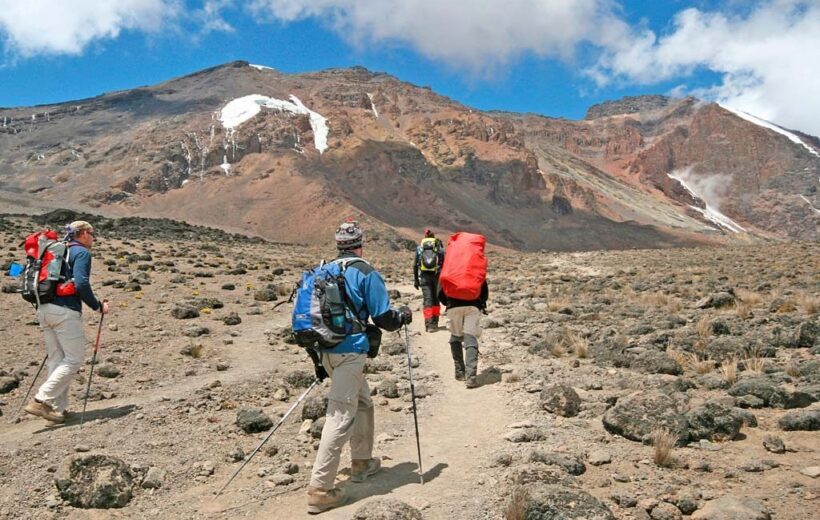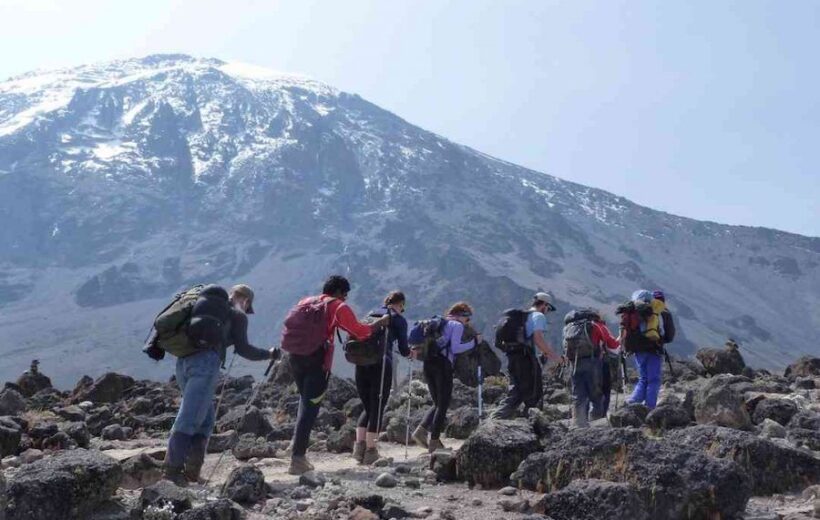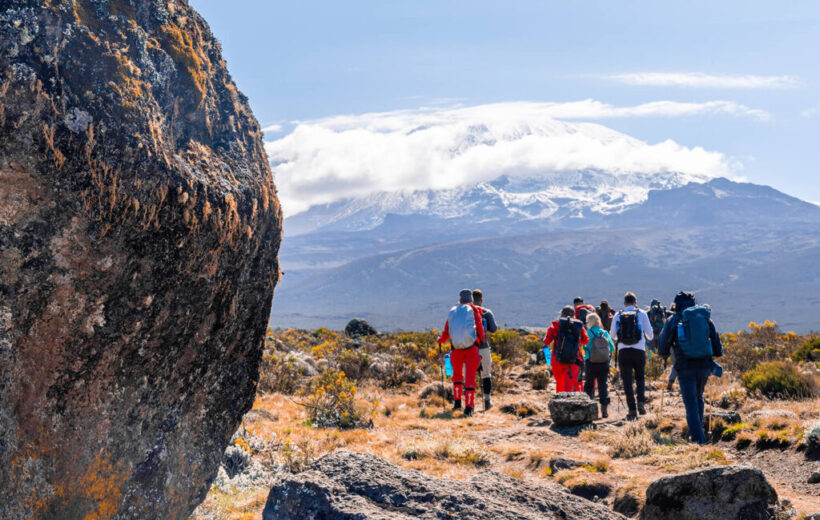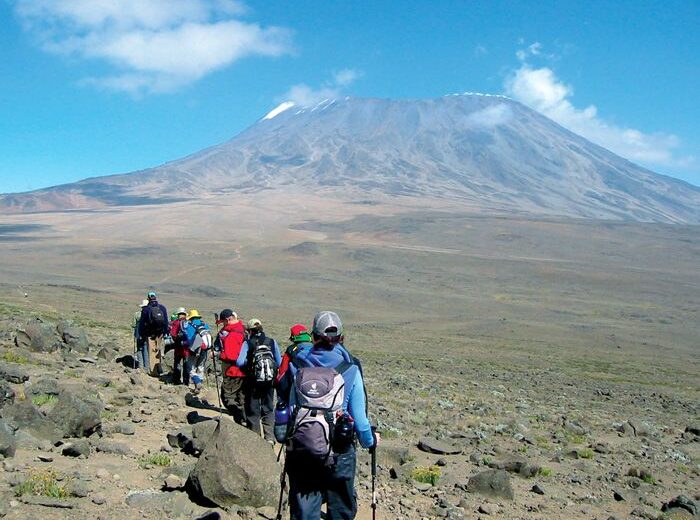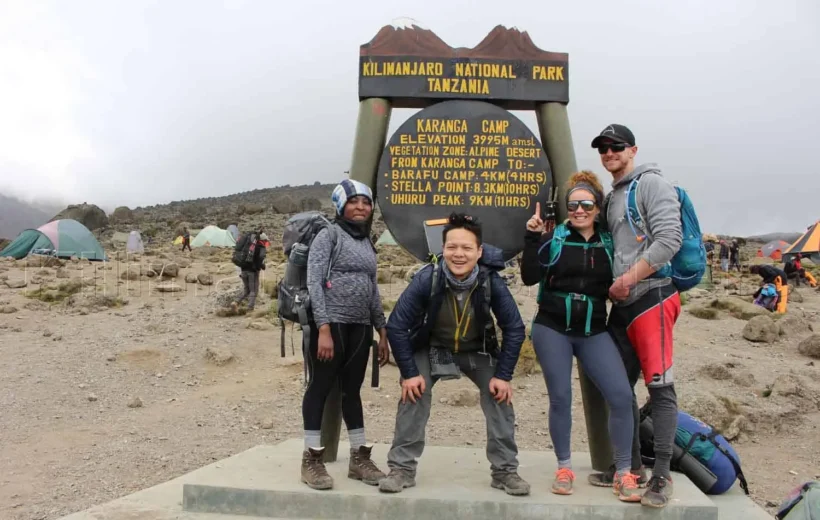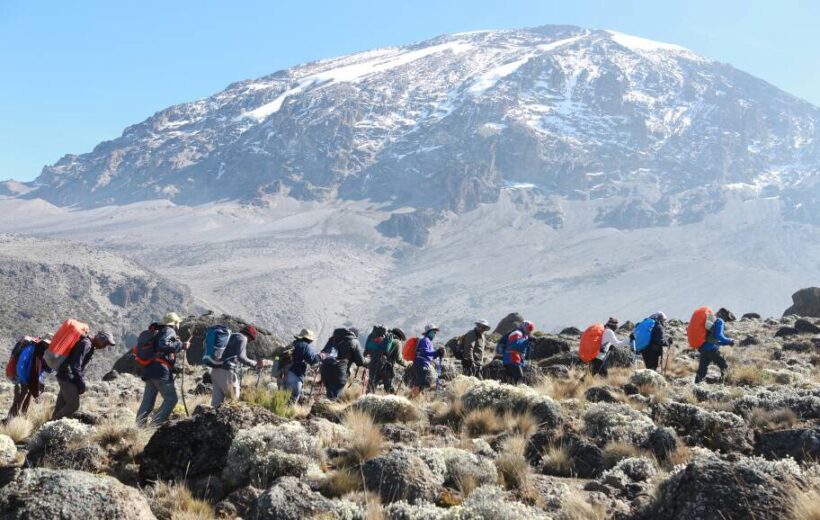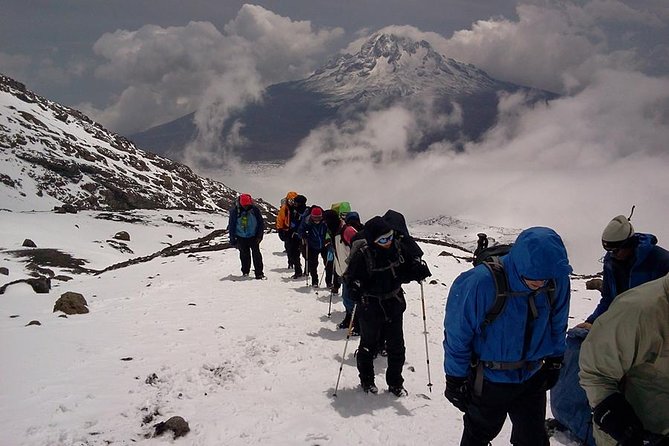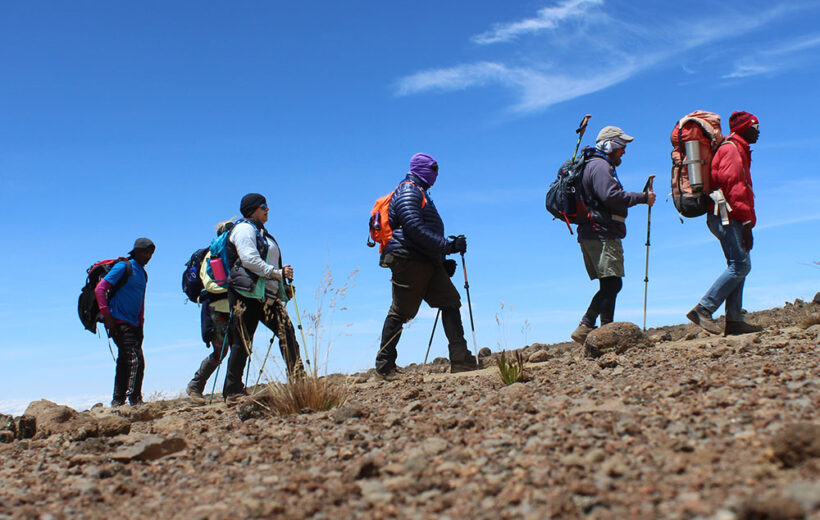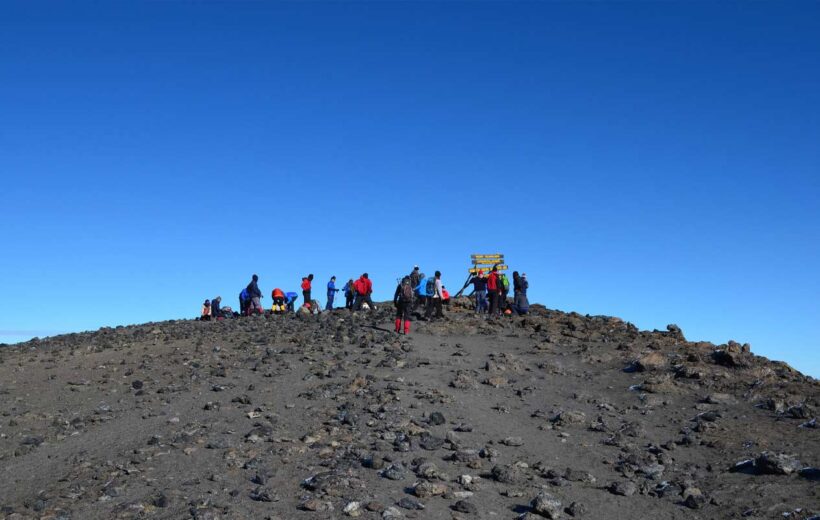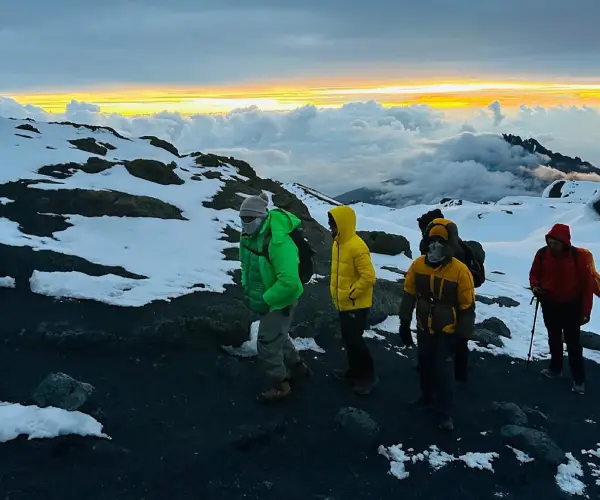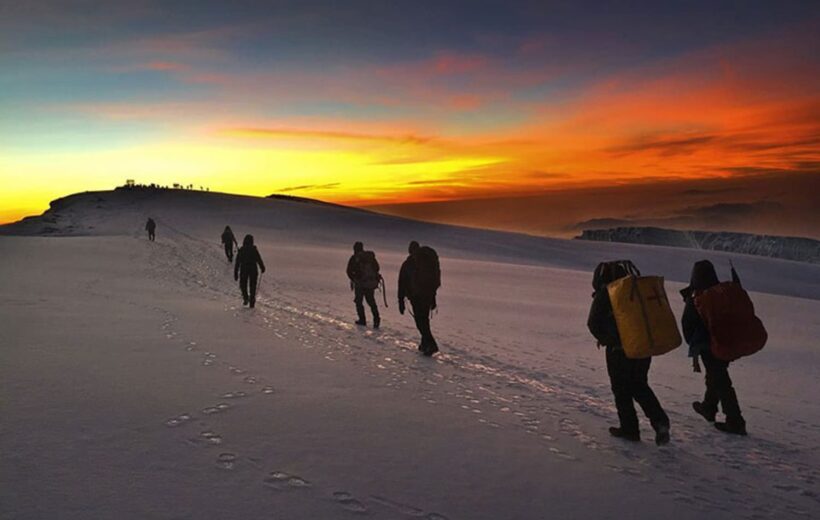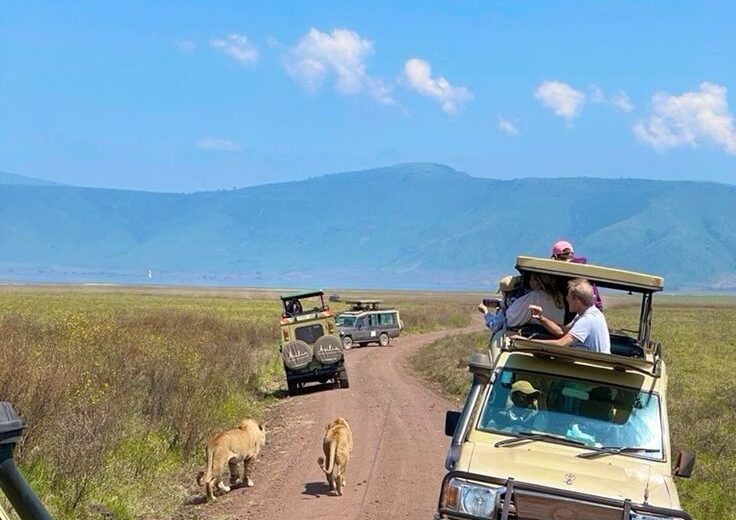Home » Trekking
Mount Kilimanjaro
Conquer Africa’s tallest peak and experience breathtaking views across Tanzania’s diverse and untamed wilderness.
Quick Navigation
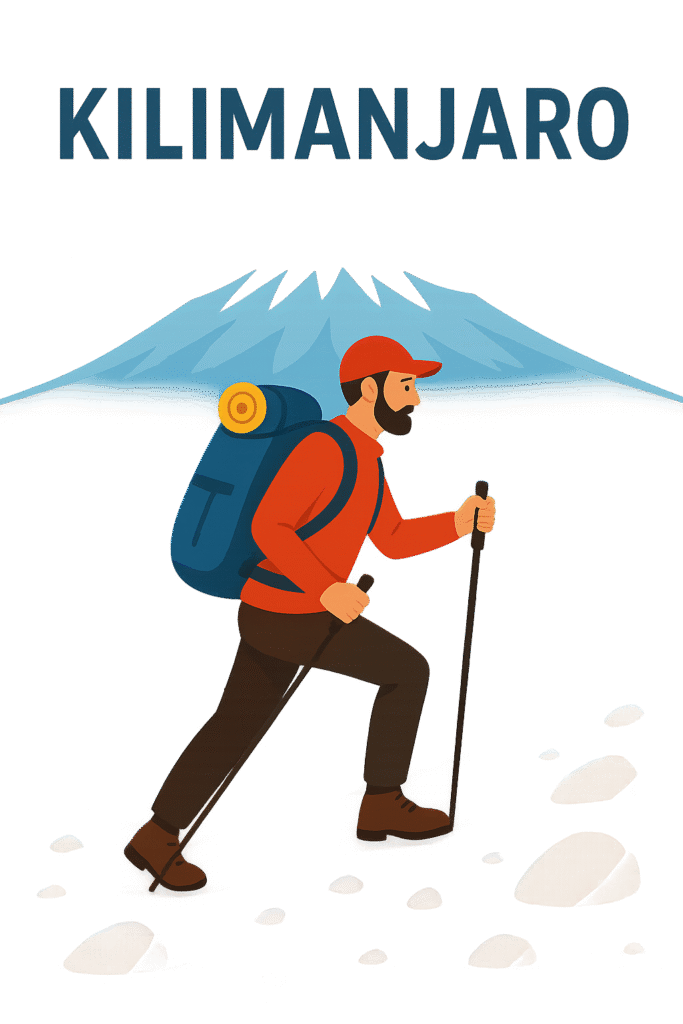
Your Ultimate Guide to Conquering the Roof of Africa
Mount Kilimanjaro stands tall as the highest peak in Africa, rising majestically to 5,895 meters (19,341 feet) above sea level. Located in northern Tanzania near the border with Kenya, this iconic mountain is not only a trekking paradise but also a natural wonder that attracts adventurers, nature lovers, and photographers from around the globe. With its snow-capped summit, diverse ecosystems, and rich cultural history, Kilimanjaro is a symbol of adventure and endurance.
Tanzania Footprints Adventures invites travelers to explore Kilimanjaro through engaging stories, helpful guides, and detailed insights into climbing, nature, and local culture. Whether you are planning your first trek or simply want to learn more, this guide will answer all your questions and help you prepare for an unforgettable journey.
Why Trek Mount Kilimanjaro?
Climbing Kilimanjaro is more than just a hike; it’s a journey through five distinct climatic zones, from lush rainforest to barren alpine desert, culminating in an arctic-like summit. It’s an opportunity to challenge yourself both physically and mentally, all while immersing yourself in one of the world’s most breathtaking natural landscapes.
A Non-Technical Summit: Unlike many of the world’s highest peaks, Kilimanjaro does not require technical climbing skills, ropes, or mountaineering experience. It is a high-altitude trek that is accessible to anyone with a good level of physical fitness and a strong will.
The World’s Highest Free-Standing Mountain: Kilimanjaro is not part of a mountain range. Its immense size and singular presence make for a truly unique and awe-inspiring landscape.
Diverse Ecosystems: Experience a “walk through four seasons in one week.” The lower slopes are home to a vibrant montane forest teeming with unique flora and fauna, while the upper reaches are a stark and beautiful alpine desert.
The Ultimate Achievement: Reaching Uhuru Peak at 5,895 meters (19,341 feet) is a monumental achievement that fills you with a sense of pride and accomplishment that few other experiences can match.
Why Choose Tanzania Footprints Adventures
In a country with many trekking companies, choosing the right operator is the single most important decision you will make. Tanzania Footprints Adventures is a locally-owned and operated company deeply committed to providing an exceptional and responsible climbing experience.
Safety is Our Top Priority: Your well-being is our utmost concern. Our guides are highly trained and certified Wilderness First Responders. We carry emergency oxygen and medical kits on every trek. We conduct daily health checks, including monitoring your heart rate and oxygen saturation levels, to ensure you are acclimatizing properly.
Unrivaled Local Expertise: Our guides and porters are not just employees; they are part of the local community. They have an intimate knowledge of the mountain, its weather patterns, and its hidden wonders. Their passion and deep respect for Kilimanjaro are a central part of the experience we offer.
Fair & Ethical Treatment: We are proud members of the Kilimanjaro Porters Assistance Project (KPAP). We ensure our porters and guides are paid fair wages, provided with proper gear, and are treated with the dignity they deserve. By climbing with us, you are directly contributing to ethical tourism practices and the well-being of the people who make these treks possible.
High-Quality Gear & Logistics: We provide top-of-the-line tents, sleeping bags, and equipment to keep you warm and comfortable in all conditions. Our dedicated mountain chefs prepare hot, nutritious meals that are essential for maintaining energy and health at high altitudes.
Exceptional Summit Success Rates: We believe in a “pole pole” (slowly, slowly) approach. Our longer itineraries are specifically designed for optimal acclimatization, giving you the best possible chance of reaching the summit safely. Our success rates consistently rank among the highest in the industry.
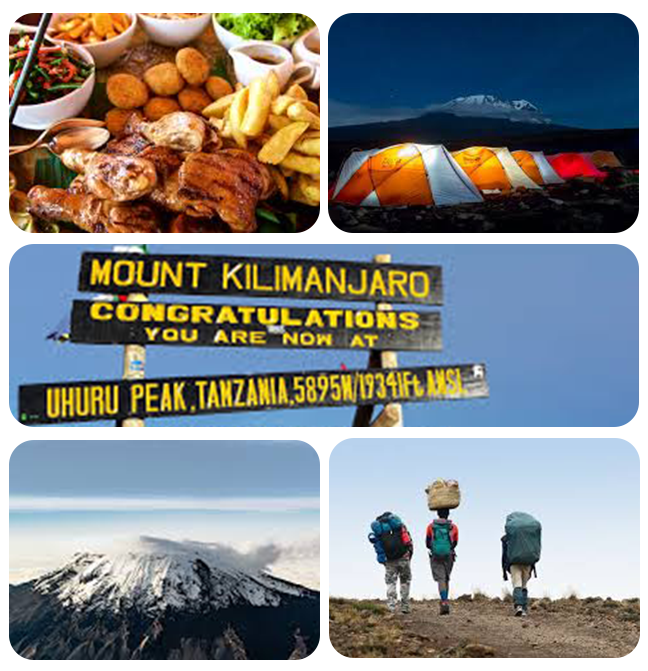

Kilimanjaro Routes at a Glance
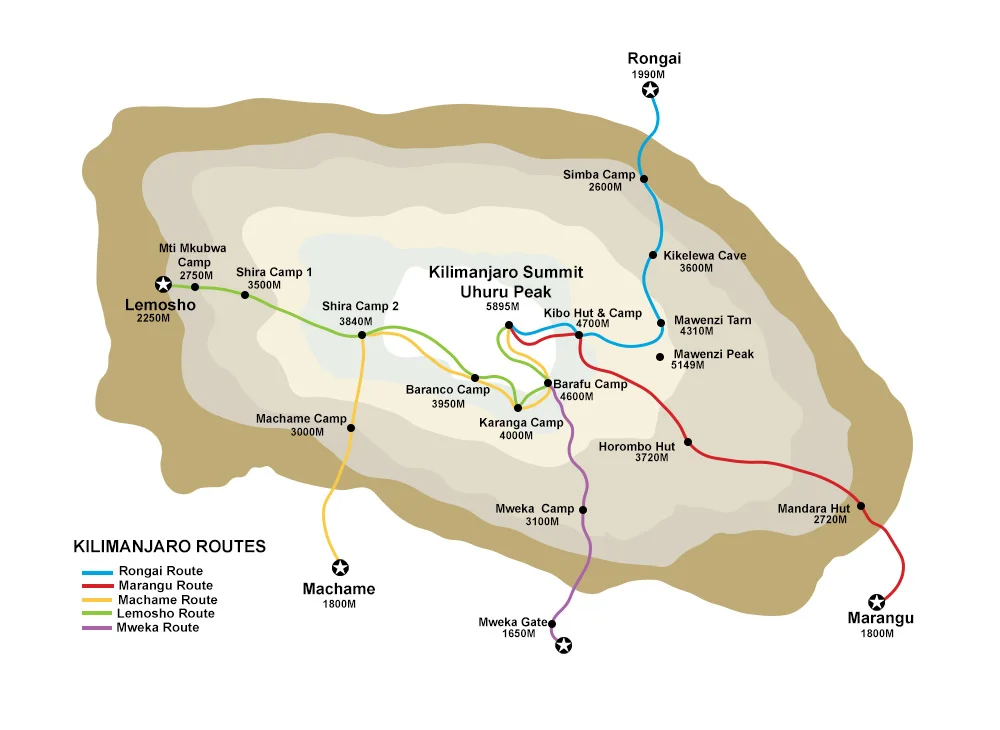
Choosing the right route is crucial for your success and enjoyment. Each route offers a unique experience in terms of scenery, difficulty, and acclimatization profile.
Machame Route (6-7 Days): Known as the “Whiskey Route,” this is our most popular choice. It’s a challenging but highly rewarding trek with a great “climb high, sleep low” profile, which is excellent for acclimatization. The scenery is spectacular, traversing diverse landscapes from the Shira Plateau to the Barranco Wall.
Lemosho Route (7-9 Days): The “Lemosho” is widely regarded as the most scenic route. It begins on the western side of the mountain and is less crowded in the initial days. Its longer duration and gradual ascent offer the highest success rates, making it an ideal choice for trekkers seeking an unhurried, breathtaking experience.
Marangu Route (5-6 Days): Affectionately known as the “Coca-Cola Route,” Marangu is the oldest and most traditional path. It is the only route that offers dormitory-style huts for accommodation, eliminating the need for camping. While it is the shortest route, its quick ascent profile can make acclimatization more difficult.
Rongai Route (6-7 Days): The only route that approaches Kilimanjaro from the north, near the Kenyan border. Rongai is a quieter and more remote trek. Its northern approach means it receives less rainfall, making it an excellent option during the rainy seasons.
Northern Circuit (9-10 Days): This is the longest and newest route, offering the highest acclimatization profile and therefore, the highest summit success rates. It circles the northern flanks of the mountain, providing unparalleled 360-degree views and an incredibly remote and wild experience.
Our Top Trekking Packages
We offer a range of packages tailored to different budgets and timeframes. All of our packages are all-inclusive, ensuring a hassle-free and unforgettable journey.
All packages includes
Professional, licensed, and English-speaking guides.
Dedicated porters and a certified mountain chef.
All Kilimanjaro National Park fees and government taxes.
High-quality camping gear (tents, mattresses, etc.).
Three hot, delicious meals a day plus snacks.
Purified water throughout the trek.
Emergency oxygen and pulse oximeter monitoring.
Accommodation before and after your trek in Moshi.
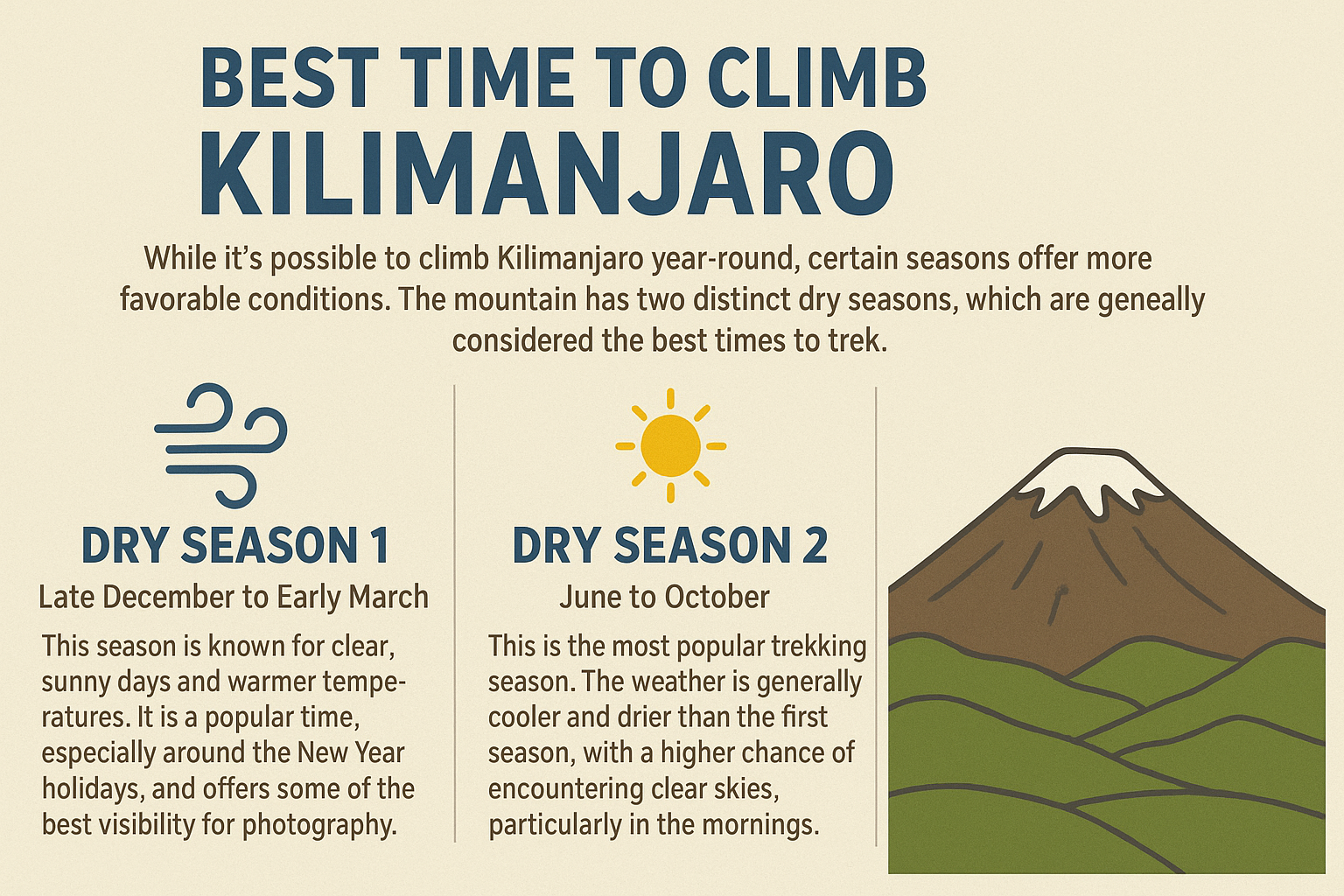
Climbing during the “shoulder seasons” (November, March, May) is also possible, but you should be prepared for potential rain and fog. The mountain is less crowded during these times, which can be a plus for some trekkers.
How to Prepare for the Trek
Conquering Kilimanjaro requires a healthy body and a determined mind. While you don’t need to be an elite athlete, a solid fitness routine will significantly increase your chances of a successful and enjoyable climb.
Physical Training: Begin your training 3-6 months before your trip. Focus on cardio activities like hiking, running, cycling, and swimming to build endurance. We highly recommend doing long hikes with a weighted backpack (10-15 kg) on varied terrain to simulate mountain conditions.
Mental Preparation: The trek is as much a mental challenge as it is a physical one. Be prepared for cold temperatures, long days, and the effects of altitude. A positive attitude and the willingness to push through discomfort are key to success.
Essential Gear: You will need the right clothing and equipment to stay warm and dry. We will provide a detailed packing list, but be sure to invest in high-quality, broken-in hiking boots, layered clothing, a waterproof shell, a warm down jacket, and a good headlamp.
Altitude & Safety on Kilimanjaro
Altitude is the main challenge on Kilimanjaro, not technical difficulty. Acute Mountain Sickness (AMS) can affect anyone, regardless of fitness level. We take a proactive approach to safety to minimize these risks.
Acclimatization: Our longer itineraries are built around the principle of “climb high, sleep low.” This gives your body time to adjust to the decreasing oxygen levels.
“Pole Pole”: Our guides enforce a slow and steady pace. This famous Swahili phrase is our mantra on the mountain and is the single most effective way to prevent altitude sickness.
Expert Monitoring: Our guides are trained to recognize the early signs of AMS. They will monitor your health and respond quickly if any issues arise. In a serious emergency, we have procedures in place for a swift descent.
Life on the Mountain
Kilimanjaro is a fully-supported trek, meaning you are cared for every step of the way.
Your Crew: You will be supported by a team of professional guides, porters, and a chef who work tirelessly to ensure your comfort and safety. They set up camp, prepare meals, and carry all the gear.
Food and Drink: Our mountain chefs are known for their delicious and varied menus, from hot oatmeal and pancakes for breakfast to hearty soups and stews for dinner. Staying well-fed and hydrated is crucial for a successful climb.
Accommodation: On all routes except Marangu, you will be camping in high-quality, all-weather tents. Our team sets up and takes down camp each day, so all you have to do is trek and enjoy the views.
Trekking Costs & What’s Included
The cost of a Kilimanjaro trek can vary significantly between operators. It’s important to understand what you are paying for. A low price often means corners are cut on guide salaries, porter welfare, food quality, or safety equipment. Our prices reflect our commitment to ethical tourism, expert guides, and uncompromising safety standards.
All-Inclusive Pricing: Our packages are designed to be transparent, with no hidden fees. The price you are quoted covers all park fees, rescue fees, accommodation (on the mountain and pre/post-trek), meals, water, and salaries for the entire crew.
Fair Wages: A significant portion of your payment goes towards providing fair wages and working conditions for our guides and porters. This ensures a happy, motivated, and experienced team.
Quality and Safety: Your investment is in your safety and the quality of your experience. We do not compromise on the best guides, reliable equipment, and essential safety measures.
Frequently Asked Questions
Where is Mount Kilimanjaro located?
Mount Kilimanjaro is located in northern Tanzania, near the Kenyan border, within Kilimanjaro National Park. It is part of the Kilimanjaro Region, a scenic area known for its fertile plains and rich Chagga culture. The nearest towns are Moshi and Arusha, which serve as gateways for climbers and tourists. Its position near the equator gives Kilimanjaro unique weather patterns that vary dramatically with altitude, creating multiple ecological zones. For adventurers, this location is ideal as it is accessible via international flights to Kilimanjaro International Airport, with several trekking routes beginning near Moshi or Marangu. Tanzania Footprints Adventures highlights Kilimanjaro’s location not only as a climbing destination but also as a natural wonder set amidst lush landscapes and vibrant local culture.
How high is Mount Kilimanjaro?
Mount Kilimanjaro reaches an impressive height of 5,895 meters (19,341 feet) above sea level, making it the tallest free-standing mountain in the world and the highest peak in Africa. Its summit, Uhuru Peak, sits on the Kibo volcanic cone and is covered with glaciers and permanent snow, despite being near the equator. The elevation creates challenging conditions for climbers, including thin air and rapid weather changes. While Kilimanjaro is a non-technical climb, altitude sickness is a common challenge due to the significant gain in height over a relatively short distance. Understanding Kilimanjaro’s elevation is essential for proper acclimatization, planning, and preparation. Tanzania Footprints Adventures ensures that trekkers receive guidance on safely approaching this extraordinary height.
Is climbing Mount Kilimanjaro dangerous?
Climbing Mount Kilimanjaro is generally safe for healthy individuals, though it presents challenges mainly due to altitude rather than technical climbing difficulty. The mountain is non-technical, meaning no ropes or climbing gear are required, but the rapid gain in altitude can cause Acute Mountain Sickness (AMS). Symptoms include headaches, nausea, and dizziness, which is why gradual ascent and proper acclimatization are crucial. Other risks include unpredictable weather, dehydration, and fatigue, all of which can be mitigated with preparation, fitness training, and guidance from experienced trekking teams like Tanzania Footprints Adventures. By following a responsible climbing schedule and using trained guides, most trekkers can safely reach the summit and enjoy the breathtaking views from Uhuru Peak.
What is the best time to climb Kilimanjaro?
The best time to climb Mount Kilimanjaro is during the dry seasons, which occur from January to mid-March and June to October. During these periods, the weather is more stable, trails are less muddy, and summit success rates are higher. Conversely, the rainy seasons (March–May and November–December) make trails slippery, increase the risk of landslides in some areas, and reduce visibility. Climbers during peak dry months may encounter more crowds, particularly in July and August, so booking in advance is recommended. Tanzania Footprints Adventures advises that careful planning around these seasons enhances the trekking experience while reducing risks associated with rain, cold, and low visibility.
Which is the easiest route up Kilimanjaro?
The Marangu Route is often considered the easiest path to climb Mount Kilimanjaro due to its gradual ascent, well-marked trails, and availability of hut accommodations. It is also called the “Coca-Cola Route” and typically takes 5–6 days, allowing a steady climb that aids acclimatization. While easier, it is less scenic compared to other routes like Lemosho or Machame, which offer diverse landscapes and more varied terrain. Marangu is suitable for beginners, yet climbers should still be prepared for high-altitude conditions. Tanzania Footprints Adventures recommends this route for travelers seeking comfort and a higher probability of summit success without technical climbing challenges.
Do you need training to climb Mount Kilimanjaro?
While Kilimanjaro is a non-technical climb, physical training is highly recommended. Trekking to nearly 6,000 meters requires endurance, cardiovascular fitness, and mental resilience. Recommended exercises include hiking with a weighted backpack, jogging, stair climbing, and strength training for core and leg muscles. Training improves oxygen utilization and stamina, reducing fatigue and the risk of altitude sickness. Tanzania Footprints Adventures provides guidance on pre-trek fitness routines and offers tips for acclimatization, ensuring trekkers are well-prepared for the challenging but rewarding journey to the summit.
Can beginners climb Kilimanjaro?
Yes, beginners can climb Mount Kilimanjaro if they are reasonably fit and follow proper acclimatization schedules. Choosing longer routes, like Lemosho or Machame, improves chances of success by allowing a gradual ascent. Guided treks with professional operators like Tanzania Footprints Adventures are essential for beginners, as guides monitor health, provide support, and ensure safety. Mental preparation, proper gear, and understanding the risks of altitude sickness are key for first-time climbers. Many beginners successfully reach Uhuru Peak with the right preparation, making the adventure both achievable and life-changing.
What animals live on Mount Kilimanjaro?
Mount Kilimanjaro hosts diverse wildlife due to its five ecological zones. In the lower cultivation and rainforest zones, you can encounter colobus monkeys, blue monkeys, bushbucks, and various bird species. The heath and alpine desert zones have fewer animals, but some rodents, hyraxes, and unique insects adapt to these harsh conditions. The summit and glacial areas are largely devoid of wildlife, but the journey offers opportunities to witness rare plants, giant groundsels, and exotic birds. Tanzania Footprints Adventures emphasizes responsible wildlife observation, helping trekkers appreciate the mountain’s biodiversity without disturbing habitats.
How many days does it take to climb Kilimanjaro?
Climbing Kilimanjaro typically takes 5–9 days, depending on the route. Shorter routes like Marangu may be completed in 5–6 days, while longer routes like Lemosho or Northern Circuit allow 7–9 days, offering better acclimatization and higher summit success rates. More days mean a slower ascent, giving your body time to adapt to high altitude. Tanzania Footprints Adventures designs itineraries that balance adventure, safety, and enjoyment, ensuring climbers experience the full diversity of Kilimanjaro’s landscapes while maximizing their chances of reaching Uhuru Peak.
How much does it cost to climb Mount Kilimanjaro?
The cost of climbing Kilimanjaro varies depending on the route, duration, inclusions, and level of service. On average, prices range from $1,500 to $3,500 per person for guided treks. Costs cover permits, park fees, guide and porter services, accommodation (huts or tents), meals, and equipment rental if needed. Tanzania Footprints Adventures offers tailored packages that provide value, safety, and comfort, ensuring trekkers receive professional guidance, high-quality meals, and personalized support throughout the journey. Choosing a reputable operator is crucial to a successful and stress-free climb.
Do I need a visa?
Most nationalities will require a visa for Tanzania. You can obtain a visa on arrival at the airport or apply for an e-visa beforehand. Please check with your local embassy for the most current information.
Traveler Reviews



About Tanzania Footprints Adventures
Tanzania Footprints Adventures is a premier tour operator based in Moshi, Tanzania. We are dedicated to providing life-changing adventures in our beautiful country, from scaling Africa’s highest peaks to experiencing the incredible wildlife on safari and relaxing on the pristine beaches of Zanzibar. Our mission is to share the magic of Tanzania with the world, always with a focus on safety, sustainability, and ethical tourism.
Ready to Conquer the Roof of Africa?
Your dream of standing on top of Mount Kilimanjaro is closer than you think. Let us guide you on this incredible journey.

